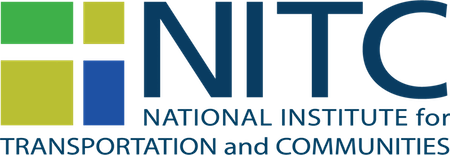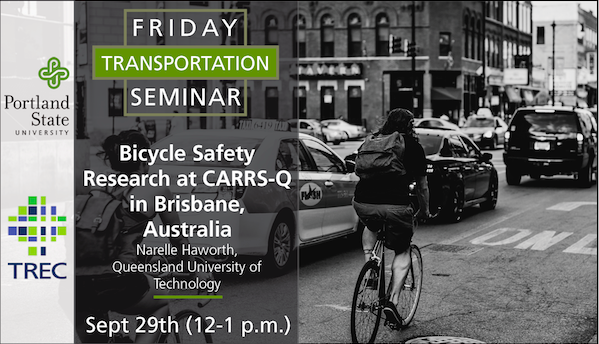The video begins at 3:45.
Kristie Gladhill, Transportation Modeler, on Modeling Safety and Urban Form.
The video begins at 1:57.
Friday Transportation Seminar: Bicycle Safety (and Other) Research at CARRS-Q in Brisbane, Australia
LOCATION: PSU, Urban Center Building, Room 204 (Distance Learning Center Wing)
LIVESTREAM ONLINE: Click here on the day of the seminar to stream it live
SEMINAR VIDEO
This presentation will begin with an overview of the activities of the Centre for Accident Research and Road Safety-Queensland. Then a number of bicycle safety research projects...
Read moreWatch video
View slides
Transportation and Road Weather
Where: Room 204 of the Distance Learning Center Wing of the Urban Center at PSU
Speaker: Rhonda Young, University of Wyoming
Topic: Transportation and Road Weather
Summary: Weather has a tremendous impact on the transportation system and is one of the largest contributors to non-recurring delay and increased crashes. Road weather is the a multidisciplinary area involving transportation engineers and meteorologists who are working to mitigate the negative effects of weather on the operation and maintenance practices of transportation systems. The talk covers the broad types of issues being studied in this field and looks at ways in which technology is playing a large part in the proposed solutions. The issue of weather as a complicating factor in the use of connected and autonomous vehicle technologies is also discussed.
Bio: Rhonda Young is an associate professor in the Department of Civil and Architectural Engineering at the University of Wyoming since 2002 and teaches graduate and undergraduate classes in Traffic Operations, Transportation Planning, Transportation Design and Traffic Safety. She completed her master and PhD degrees in Civil Engineering at the University of Washington and...
Read moreThe video begins at 4:55.
Abstract: The new safety paradigm, Vision Zero is built around the basic idea that even if not all traffic crashes can be avoided, all severe injuries can, in principle, be avoided. Building a "safe system," where all predicted crashes have tolerable health losses, requires a new roadway design philosophy. This new philosophy calls for shifting from the traditional preventing crashes to preventing health harm. This shift calls for switching from designing roads to have space for evasive action to managing the kinetic energy transferred in crashes to human bodies to be within its injury tolerance.
Watch video
View slides
Summary: Cycling is on the rise across the U.S. and its popularity has grown beyond the usual leaders - Portland, OR, Seattle, WA, Davis, CA, Minneapolis, MN and Boulder, CO. New York City, NY Chicago, IL and Washington, DC are among those cities making significant investments in bike infrastructure in recent years and have realized substantial growth in people taking to the streets on two wheels. This presentation will summarize some results from our comprehensive assessment of the safety, operations, economic impacts, user experience, and perceptions of new protected bikeways in 5 cities U.S. cities (Austin, TX; Chicago, IL; Portland, OR; San Francisco, CA; and Washington, D.C.). To support this research, the team collected and analyzed 204 hours of video, 2,300 returned surveys of residents, and 1,111 returned surveys from people intercepted riding the new facilities.
Bios: Dr. Christopher M. Monsere is an Associate Professor of Civil and Environmental Engineering in the Maseeh College of Engineering & Computer Science at Portland State University. Dr. Monsere’s primary research interests are in the areas of multimodal transportation safety; management and dissemination of large transportation datasets; and improvements in transportation...
Read more
